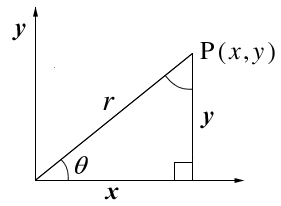Pythagorean Trigonometry a quick proof

[Sin(x)]^2+[Cos(x)]^2=1. This is one of the first proofs that we learn in trigonometry. It is based on the pythagorean formula.
Okay lets have a few definitions:
On a right triangle:
Sin(x)=opposite leg/hypotenuse or =opp/hyp
Cos(x)=adjacent/hypotenuse or =adj/hyp
The pythagorean theorem (on the same triangle)
(opp)^2 + (adj)^2=(hyp)^2
Everything is defined so lets divide both sides of the pythagorean equation by (hyp)^2. We now have:
(opp)^2/(hyp)^2 + (adj)^2/(hyp)^2= 1
Again we know that Sin(x)=opp/hyp and Cos(x)=adj/hyp.
Therfore: [Sin(x)]^2+[Cos(x)]^2=1
We can also do this with other trignometric functions. Lets look at tan(x) and sec(x)
tan(x)=opp/adj and sec(x)=hyp/opp
Back again to the pythagorean formula but we are going to change it a little bit:
adj^2=hyp^2 -opp^2 (This can be done by subtracting opp^2 from both sides)
Lets divide both sides of the pythagorean formula by adj^2 and we have:
1=hyp^2/adj^2-opp^2/adj^2
Now remember: tan(x)=opp/adj and sec(x)=hyp/opp so:
1=[sec(x)]^2-[tan(x)]^2 or [tan(x)]^2 + 1=[sec(x)]^2
Can you do the proof of this trigonometry identity:
[cot(x)]^2 +1=[csc(x)]^2?








